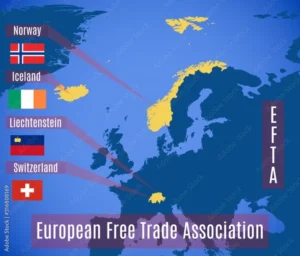Trade and Economic Partnership Agreement (TEPA) of India with EFTA | UPSC
- Context: India signed a free trade agreement (FTA) named Trade and Economic Partnership Agreement (TEPA), with four European Free Trade Association (EFTA) countries — Iceland, Liechtenstein, Norway, and Switzerland.

Analysis
Goal:
- The stated goal of the agreement is reaching $100 billion in investments in India and one million jobs within 15 years.
Read also: WTO Stockholding Limits Peace Clause | UPSC
Features:
- a) The Trade and Economic Partnership Agreement (TEPA) marks the second such full-fledged FTA signed after India’s agreement with the United Arab Emirates.
- b) The agreement will see considerable tariff reductions, increase market access, and simplify customs procedures.
- c) The FTA also included a chapter on commitments to human rights and sustainable development.
European Free Trade Association (EFTA)
- The European Free Trade Association (EFTA) is an intergovernmental organisation of Iceland, Liechtenstein, Norway and Switzerland.
- It was set up in 1960 by the Stockholm Convention for the promotion of free trade and economic integration to the benefit of its four Member States and the benefit of their trading partners around the globe.
- The EFTA States are not obliged by the EFTA Convention to conclude preferential trade agreements as a group.
-
- They maintain the full right to enter into bilateral third-country arrangements.
-
a) How is EFTA different from the EU?
- The European Free Trade Association (EFTA) countries are separate from the European Union (EU).
- EFTA does not envisage political integration. It does not issue legislation, nor does it establish a customs union.
- European Union (EU) is an international organization comprising 27 European countries and governing common economic, political, social, and security policies.
- The EU was created by the Maastricht Treaty.
European Economic Area (EEA)
- As of February 2024, the EEA comprises of 27 EU Member States and the three EFTA States – Iceland, Liechtenstein and Norway.
- It seeks to strengthen trade and economic relations between the contracting parties.
- It is principally concerned with the four fundamental pillars of the internal market, namely: the free movement of goods, people, services and capital.
Levels of Integration
- Broadly, there are six stages or levels of economic integration:
a) Preferential Trade Area
- Reduction in customs tariffs between the countries participating in the project.
b) Free Trade Area
- Elimination of the tariffs applicable to all or part of the goods that circulate between the participating countries.
c) Customs Union
- Establishment of common tariffs vis-à-vis third countries and a common trade policy.
d) Common Market
- Development of regulations for most goods and services, allowing for the free circulation of goods, capital, workers and services.
e) Economic Union
- Harmonisation of certain national economic policies: monetary, financial, tax, industrial, agricultural, etc.
- Monetary policy can result in the creation of a common central bank and the adoption of a common currency, which would lead to a monetary union.
f) Economic Integration
- Establishment of an economic space governed by common economic policies which also needs an institutional organisation with effective powers.
- Note: The European Union has already achieved the four initial levels of integration and is currently in the process of economic union.
- Great progress has been made towards monetary union, with the introduction of a common currency (the euro) and the application of a single monetary policy in a significant number of countries.
g) Increasing order of economic integration
- Preferential Trade Area -> Free Trade Area -> Custom Union -> Common Market -> Economic Union -> Economic Integration
Practice Questions:
Q1. With reference to India’s signing of a free trade agreement (FTA) with four European Free Trade Association (EFTA) countries, consider the following statements:
- EFTA is a political and economic union of four countries.
- All the EFTA countries are part of the European Economic Area (EEA).
- The EFTA States are obliged by the EFTA Convention to conclude preferential trade agreements as a group.
How many of the above statements are correct?
a) Only one
b) Only two
c) All three
d) None
Answer: d
Q . With reference to India’s signing of a free trade agreement (FTA) with four European Free Trade Association (EFTA) countries, consider the following statements:
- It marks the first such full-fledged FTA India has signed with any country or group of countries.
- The agreement allows for the free circulation of goods, capital, workers and services.
- The FTA includes a chapter on commitments to human rights and sustainable development.
Read also: Dry Bulb vs Wet Bulb Temperature Explained | UPSC
How many of the above statements are correct?
a) Only one
b) Only two
c) All three
d) None
Answer: a
Q. What is the European Free Trade Association (EFTA), and how does it compare to the European Union (EU)? Provide examples from India’s trade relations. (Answer in 250 words)

